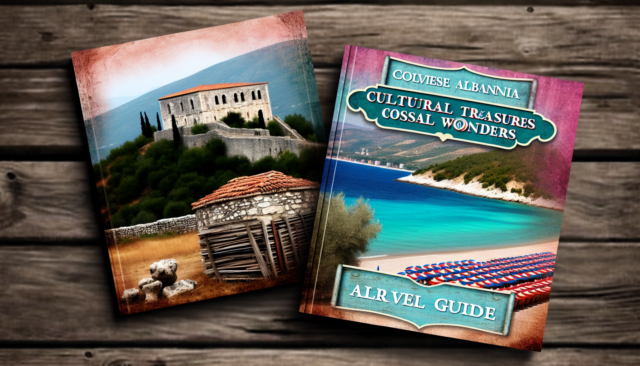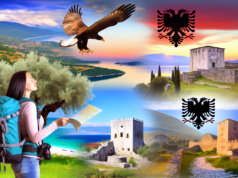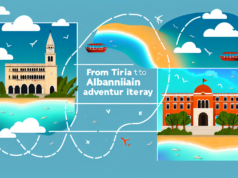
Albania, a hidden gem nestled in the Balkans along the Adriatic and Ionian Seas, is a country rich in cultural history and natural beauty. With its breathtaking landscapes, vibrant traditions, and ancient heritage, Albania offers a stunningly diverse travel experience for adventurers, history buffs, and beach lovers alike. This comprehensive travel guide will take you through the diverse regions of Albania, highlighting its cultural treasures and coastal wonders.
Discovering Albania’s Cultural Heritage
1. Tirana: The Vibrant Capital
Tirana, the capital city, is a mosaic of modernity and history. Begin your exploration at Skanderbeg Square, named after the national hero Gjergj Kastrioti Skënderbeu, who fought against Ottoman rule. The square is surrounded by significant landmarks including the National History Museum, which showcases the rich history of Albania from ancient Illyrians through the communist era.
Stroll through the Blloku neighborhood, once an exclusive area for the communist elite, now a bustling hub of cafes, galleries, and nightlife. The colorful buildings here highlight the city’s artistic revival, making it a must-see for any traveler.
2. Berat: The City of a Thousand Windows
Approximately 120 kilometers south of Tirana lies Berat, a UNESCO World Heritage site famed for its well-preserved Ottoman architecture. As you wander the cobbled streets of the Mangalem and Gorica neighborhoods, you’ll be treated to the sight of whitewashed houses stacked up the hillside, adorned with windows that appear to gaze down upon the city.
Visit the impressive Berat Castle, where you can explore the ancient churches and take in panoramic views of the Osum River Valley. Don’t miss the Onufri National Museum, housed in the castle, which exhibits exquisite icons and ecclesiastical art.
3. Gjirokastër: A Castle on the Hill
Another UNESCO World Heritage site, Gjirokastër is renowned for its stone houses and the formidable Gjirokastër Castle, which dates back to the 13th century. The castle offers impressive views and houses the National Museum of Armaments, showcasing the military history of Albania.
Strolling through the charming old town, you will encounter narrow streets, traditional bazaars, and cultural sites that reflect the blend of Albanian and Ottoman influences. Make sure to sample the local cuisine, including the famous byrek and the delicious qifqi, rice balls flavored with herbs.
The Natural Beauty of Albania’s Coastline
4. The Albanian Riviera
The Albanian Riviera is often hailed as one of Europe’s best-kept secrets, boasting crystal-clear waters, dramatic cliffs, and picturesque beaches. Start your coastal journey in the vibrant town of Saranda, which serves as a gateway to the ancient city of Butrint—another UNESCO World Heritage site. The archaeological park boasts ruins dating back to the Greek and Roman periods, providing a fascinating glimpse into the area’s historical significance.
Next, head to the idyllic beaches of Ksamil, known for their stunning turquoise waters and small islands. Relax on the sandy shores or take a boat trip to explore the nearby islets.
5. Dhermi and Jale Beach
Continuing along the Riviera, you’ll reach Dhermi, a charming village with beautiful beaches and a laid-back atmosphere. Make sure to explore its pebble-strewn shores and enjoy the vibrant nightlife.
Just a short drive away lies Jale Beach, famous for its lively ambiance and beach bars. This stretch is perfect for water sports enthusiasts, offering opportunities for snorkeling, jet-skiing, and other activities.
6. Vlora: Where Seas Meet
Vlora, located at the point where the Adriatic and Ionian seas meet, is a vibrant port city that boasts a rich history as well as stunning coastal views. Visit the Independence Square, where Albania declared independence from the Ottoman Empire in 1912, and explore the nearby beaches of Radhimë and Orikum for relaxing sun-soaked days.
Experiencing Albania’s Traditions and Cuisine
7. Culinary Delights
Albanian cuisine is a reflection of its diverse cultural influences, characterized by fresh ingredients and hearty dishes. Don’t miss trying traditional foods such as tavë kosi (baked lamb and yogurt), fërgesë (pepper and tomato stew), and dolma (grape leaves stuffed with rice and meat).
Pair your meals with local wines, notably from the regions of Berat and Saranda, which produce some of the finest varieties. Be sure to try raki, a potent grape brandy, often homemade and served as a gesture of hospitality.
8. Local Festivals and Traditions
Albania is rich in folklore, music, and dance. If your travel coincides with local festivals, such as the National Folklore Festival in Gjirokastër, you will experience traditional performances showcasing the country’s diverse cultural heritage. Engaging with locals and participating in these celebrations will deepen your understanding of Albanian life.
9. Outdoor Adventures
For those seeking adventure, Albania’s diverse terrain offers plenty of opportunities. The Albanian Alps, or "Accursed Mountains," are perfect for hiking, with trails leading through stunning valleys and snow-capped peaks. The Theth National Park and Valbona Valley are particularly popular among trekkers and nature enthusiasts.
Conclusion
Albania is a country where cultural treasures and coastal wonders coexist harmoniously, providing travelers with unforgettable experiences. Whether you are exploring ancient castles, soaking up the sun on picturesque beaches, or savoring traditional Albanian flavors, the allure of this Balkan paradise will leave a lasting impression. Both off the beaten path and rich in history, Albania beckons travelers ready to uncover its remarkable stories and stunning landscapes. So pack your bags and get ready to embark on an adventure through this enchanting land!













